Drought and climate change are wreaking havoc on an icon of Pacific Northwest forests. How long do the western redcedars have?

Old soul: Healthy western redcedars are still around. But in decline. Photo: Nathan Gilles
By Nathan Gilles. August 18, 2022. Their branches drop gracefully, then curve upward to their tips.
They’re conifers, yet they don’t have coarse, rough needles.
Instead, they have soft, folded, scale-like “leaves,” bright green when new, darker when old. Their trunks—covered in thin reddish-brown bark—can grow to nearly 20 feet in diameter, though they aren’t ramrod straight like a Douglas fir, but noticeably wider at their bottoms, where flowing buttress-like structures form.
They grow as understory trees for much of their lives, but they can also stretch to the forest overstory, reaching heights of up to 200 feet.
They’re a key part of Pacific Northwest ecosystems, though they rarely dominate the forest, often living alongside firs, hemlocks, alders and maples.
These trees are the Pacific Northwest’s iconic western redcedars (Thuja plicata).
To many indigenous peoples, who used the trees for houses, clothes, weapons, tools, medicines, art and canoes, they’re known as The Tree of Life.
They’ve been recorded to live for over 1,500 years.
But these trees are now dying.
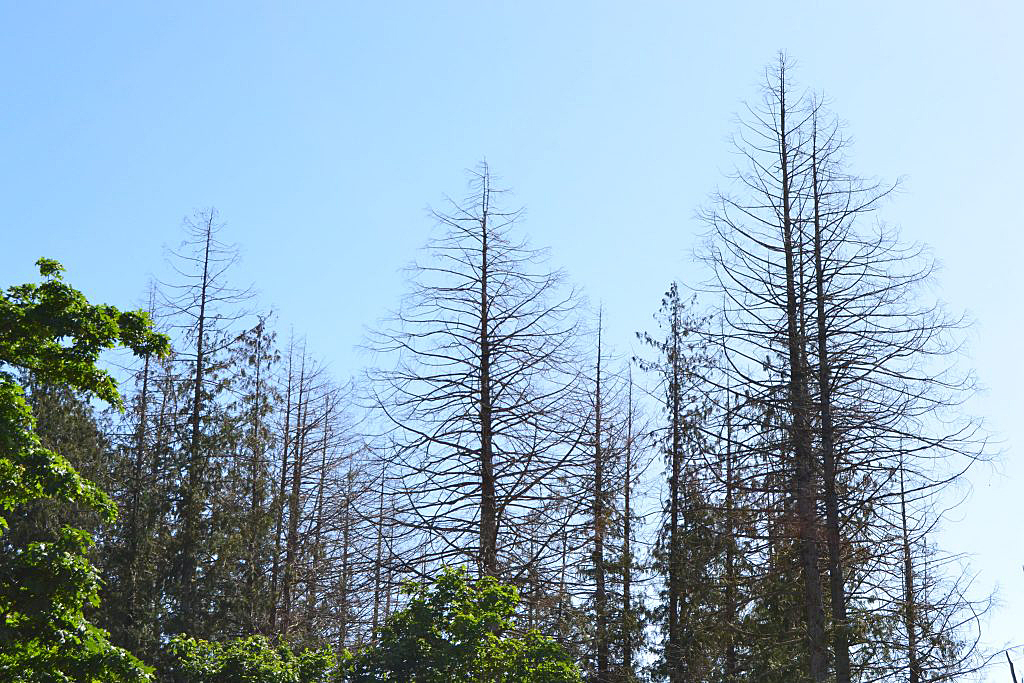
Heat exhaustion: Stark evidence of dieback. Photo: Joseph Hulbert
For at least a decade, struggling and dead western redcedars have been reported throughout the Pacific Northwest.
But the cause and extent of the dieback (a condition in which a tree or plant begins to die from the tip of its leaves or roots inward) have long remained unknown.
Now we have the answers.
The dieback is widespread, and the cause appears to be climate change.
What’s more, we now know that the dieback could be the beginning of the end for the species in many parts of the Pacific Northwest.
Separate studies agree
Earlier this year, scientists from the Oregon Department of Forestry, the Washington Department of Natural Resources and U.S. Forest Service published the results of a two-year study on the dieback.
The study concludes not only that the cedar dieback is happening throughout Oregon and Washington, but also that the dieback is not the result of a biotic agent—such as a fungi or insect attack—but due to climate, namely the decades-long drought affecting Oregon and Washington.

Current and predicted distributions of western redcedar under a high-warming climate change scenario. Red indicates the highest degree of viability. Green indicates less viability. Maps cited in recent government report by Nicholas Crookston and colleagues.
Columbia Insight was given a copy of the official report for the study ahead of publication by the project’s lead scientists. The study’s results are also available online on a public website.
Now a second, yet-to-be-completed study from Washington State University is arriving at similar conclusions.
While the government report falls short of saying climate change is killing western redcedars, the public website refers to the drought as “climate change-induced.”
But by far the most interesting climate change connection in the report and on the website is a reference to previous research that predicts the range of the western redcedar will change significantly as temperatures rise throughout this century.
The website speculates, “We could be seeing the range of WRC [western redcedar] shift or shrink due to changing conditions that reduce the suitability of some sites for this species.”
Where they are … for now
Western redcedars, and plants in general, have a growing range—sometimes called a distribution or climate envelope—that’s defined by climate conditions: how much moisture they need and what temperature range they need to grow and can tolerate.
The western redcedar has a range that runs west to east from the Pacific Ocean to western Montana, and south to north from northern California at the Mendocino coast to the Southeast Alaskan panhandle.
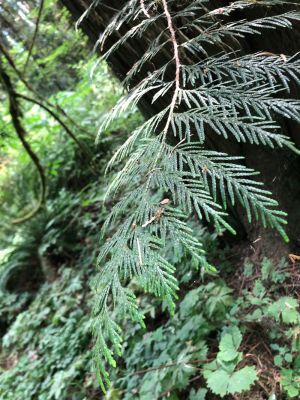
Reaching out: Western redcedars are among the oldest living things in the Pacific Northwest. Photo: Nathan Gilles
There are large breaks in the range, namely the dry regions east of the Cascade Mountains’ rain shadow, where the trees simply will not grow—though there’s a small distribution in eastern Washington where the Rocky Mountains intersect with the state.
The elevations at which western redcedars can grow vary from sea level to 7,000 feet in the south and from sea level to 3,000 feet in the north.
This range, however, is expected to change, shifting in some regions and shrinking in others, as the climate warms.
The government report cites previous research showing that by the end of this century the western redcedar’s range is likely to disappear at lower elevations west of the Cascades and will disappear almost entirely from eastern Washington, shifting north and eastward into the Rockies in Montana and Canada.
In western Oregon and Washington, researchers observed dieback at lower elevations—in Oregon in the Willamette Valley and in Washington in the urban corridor running from Olympia to Puget Sound.
By contrast, in the tree’s distribution in eastern Washington, dieback was observed throughout the tree’s elevational range.
“What we’re seeing is probably true to what most [scientific] models that have been developed [have predicted], though it’s obviously not going to be exact,” says Melissa Fischer, forest entomologist and lead researcher on the dieback for the Washington State Department of Natural Resources and coauthor of the official report.
Trees heading north
For decades, climate scientists studying the Pacific Northwest have warned that the region will experience warmer, longer summers and more frequent and severe droughts as the region continues to warm under human-caused climate change.
As a result, the ranges of many plant species are expected to shift northward in latitude and upward in elevation.
However, this process won’t be a smooth movement north and uphill—after all, trees migrate through reproduction, one generation following another, rather than by walking.
Instead, the range shifts are expected to be aided by diebacks that will occur when the climate outside the trees no longer matches the biological needs set by the genes inside the trees.
Wildfires are also expected to play a role, so that by the end of this century, the region’s conifer-dominant forests are expected to give way to mixed conifer and deciduous stands, and trees now common in California will find their ranges shift northward to the Pacific Northwest.
Christine Buhl, forest entomologist and lead dieback researcher at the Oregon Department of Forestry, says it’s too soon to tell whether the dieback is the start of a range shift for western redcedar, adding that the observations certainly look that way.

Shrinking not shifting: ODF’s Christine Buhl. Photo: Oregon Department of Forestry
But Buhl isn’t fond of the word “shift,” which she says doesn’t quite capture what happens when a tree’s range moves up in elevation.
“What we’re observing could be a range shift,” says Buhl, “but more likely, from what we have found, it could be a range shrinkage.”
Buhl says “shrinkage” is a more accurate way to describe the elevational data, because there is less area the further upslope a tree’s range moves.
With a rise in elevation, she says, “it’s going to shrink the area available to [western redcedars].”
Betsy Goodrich, a forest pathologist stationed at the Okanogan-Wenatchee National Forest, report author and lead researcher on the western redcedar dieback for the U.S. Forest Service, says she hasn’t looked closely enough at the model predictions to have a strong opinion on whether the current western redcedar dieback could be part of a range change for the trees.
However, she says it’s not a stretch to conclude that if the dieback is due to drought and more droughts are expected in the future, then the trees probably won’t reestablish themselves in some places.
“I think it’s pretty safe to say, if you see [a location where] western redcedar is declining that’s not going to be a good location for western redcedar if we are expecting warmer more frequent droughts,” says Goodrich.
One good rain year won’t do much
Western redcedars, which aren’t as good as many other trees at slowing water loss during warm and dry conditions, seem to be especially vulnerable to droughts, and the researchers’ findings point in that direction.
The major climate event impacting the trees, say the researchers, has been the drought.
According to the U.S. Drought Monitor, which is cited in the report, both Oregon and Washington have been in some form of drought since the start of this century.
To be sure, the two-decade period included both wet and dry periods.
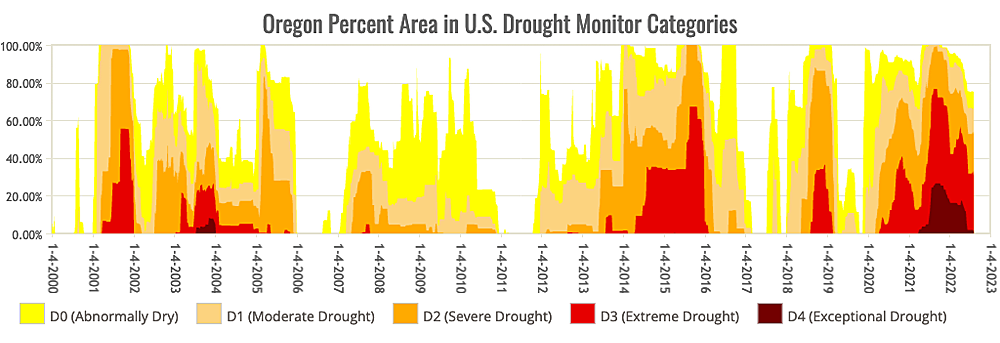
Oregon is getting drier. That’s trouble for a lot of trees. Chart: U.S. Drought Monitor
But lack of precipitation alone doesn’t define a drought. Which is why the Monitor, and scientists generally, use more complicated metrics that track factors such as soil moisture as well as heat and drought stress on plants, all of which are affected by warm temperatures.
Temperatures over the two-decade period were warm, trending higher than previous decades—leading to dry soils and stressed plants. Buhl says this longer trend helps explain what’s happening to western redcedars.
“When the trees are damaged one year,” says Buhl, “they don’t just bounce back the next year mainly because they have lost essential tissues that take a long time to rebuild, and when they don’t have those [tissues] to collect moisture to translocate throughout the tree, then one year of rain isn’t going to do very much for the tree because it can’t collect [moisture].”
In other words, the trees get caught in a Catch-22. They need tissue to collect water, but to grow that tissue they need water … and so on.
In the field, Buhl and colleagues observed this as “yellowing,” when leaves turn yellow from lack of water, “flagging,” when brown leaves and branches occur on otherwise healthy trees, “top kill,” when a tree’s top dies because water cannot reach it and as dead trees.
‘Community science’ effort
The trees also don’t seem to be getting water when they need it in late spring and early summer.
“Late spring water, May-June precipitation is critical,” says Joseph Hulbert, a researcher at WSU.

Tree watcher: Joseph Hulbert. Photo: WSU
Hulbert leads the Western Redcedar Dieback Project, a related but largely separate effort to track the dieback. (His project shares data and compares methodology in a limited way with Buhl, Fischer and Goodrich.)
Hulbert says he’s reached similar conclusions about both the extent and cause of the dieback, saying his analysis, though still in the process of completion, strongly suggests the dieback is climate-related.
“It’s one of the first species to feel the heat if you will,” says Hulbert.
As of this writing, Hulbert’s project has made over 1,700 observations, recording the location of both healthy and unhealthy trees. This has included not only observations of dieback in Oregon and Washington, but observations of dieback in California and British Columbia.
Hulbert’s project was able to do this because, in addition to more traditional methods, the project is in part a “community science” or “citizen science” effort. This means it relies on observations from members of the public to collect some of its data, in this case, people with a little training in what to look for and the iNaturalist app, created by National Geographic and the California Academy of Sciences.
The app, which is being used in other community science efforts, allows users to geo-locate trees, identify signs of both tree dieback and health and then send those observations to Hulbert.
“We’ve revealed that this is happening all the way from northern British Columbia all the way through Oregon, probably also in California, so the whole distribution [of the species],” says Hulbert.
Stressed-out trees
Since a biological cause (or causes) couldn’t at first be ruled out, researchers from both projects looked for signs of insect attacks—including from bark and woodboring beetles, or from fungal infections—including from fungi known to cause root rot.
Here Hulbert’s project took a more traditional approach, working with students from local colleges to track biotic agents.
Both sets of researchers found signs of fungal and insect damage, but only on some not most of the trees experiencing dieback.
Western redcedars contain a number of anti-pest compounds, one of the reasons the trees are prized as a building material. That the trees showed signs of biotic attacks at all was a bit surprising and is itself an argument for drought-induced stress, according to the researchers.
“They [biotic agents] are secondary,” says Goodrich. “They come in when the tree is stressed. So, it does point more to stress than a biotic damage agent.”
According to Mathew Betts, Oregon State University professor in the College of Forestry, who was not involved in the study, being susceptible to disease is exactly what one would expect when a species’ range is shifting due to climate change.
“There are a number of stressors that can be induced by warming or drying that could affect species’ abilities to persist,” says Betts.
In fact, says Betts anywhere there is a mismatch between a species’ current range and its predicted future range, we can expect that species will “do pretty poorly.”
This and other aspects of the report, says Betts, suggest the western redcedar could be starting a range shift.
“We’ve been making predictions for years about what species will do when their climate envelopes move beyond them,” said Betts. “And there is evidence in this [government western redcedar dieback] study that suggests that those models aren’t wrong.”
Climate refugia
However, says Betts, the models also aren’t perfect. His own research suggests where they fail.
In a 2016 paper in the journal Science Advances, Betts and colleagues were able to demonstrate that old-growth forests in complex topographies with multiple land features, could be 2.5 degrees Celsius (4.5 degrees Fahrenheit) cooler than surrounding areas.
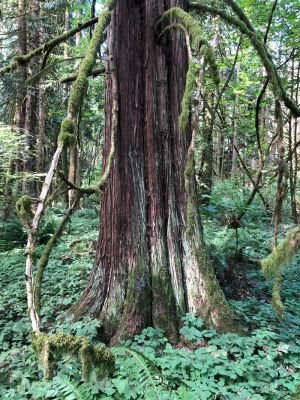
Natural beauty: Western redcedar in Washington. Photo: Nathan Gilles
This is significant, says Betts, because, according to some predictions, the global climate is expected to warm by around 2-2.5 Celsius.
This failure to account for microclimates, says Betts, suggests that while their native ranges shrink and shift western redcedars and other trees susceptible to climate change might hang on in small enclaves in parts of these ranges, called “climate refugia.”
“The hope is that some of those species that are climate sensitive will be able to hang on in those [climate refugia] locations,” says Betts.
Fischer says she has observed microclimate effects in her fieldwork.
“Oftentimes when I’m at a spot looking at dieback,” says Fischer “there are also trees that are healthy. And healthy trees tend to be shaded out, usually in the understory or they are shaded by topography, for instance, they’re on the northern side of a hill.”
Fischer says this issue of topography, which she notes wasn’t part of her team’s official analysis, needs to be studied more.
In fact, all the dieback researchers interviewed for this story agree there’s a lot more we need to learn about western redcedars in order to protect them.
Future research
The one topic the researchers agree needs to be examined more thoroughly is the rate at which the dieback is happening.
No one yet knows how fast the dieback is killing trees, and this, says Fischer, will be a big factor in when and if the trees can migrate to their new climatic homes.
“If mortality and dieback occur at a really fast rate,” says Fischer, “it’s not like the trees are going to have the ability to migrate. That is a very slow process.”
Hulbert says he sees “assisted migration,” or intentionally planting trees where they are predicted to grow in the future, as one option.
As part of a new effort called the Open Redcedar Adaptation Network, Hulbert says he hopes to experiment with western redcedar seed stock from across the Pacific Northwest in order to find trees that will be the most likely to survive in a warmer world.
So far, the project has planted trees from Oregon in three Washington cities: Seattle, Tacoma and Renton.
But, says Hulbert, this effort is just a pilot project and was not designed to be scientifically rigorous but intended to be used as an educational tool in schools.
Hulbert says he hasn’t secured the funding needed to continue this and similar efforts to build on his current research, but that more research is needed to save the western redcedar.
“Probably the only hope for the redcedar is to start experimenting,” says Hulbert.





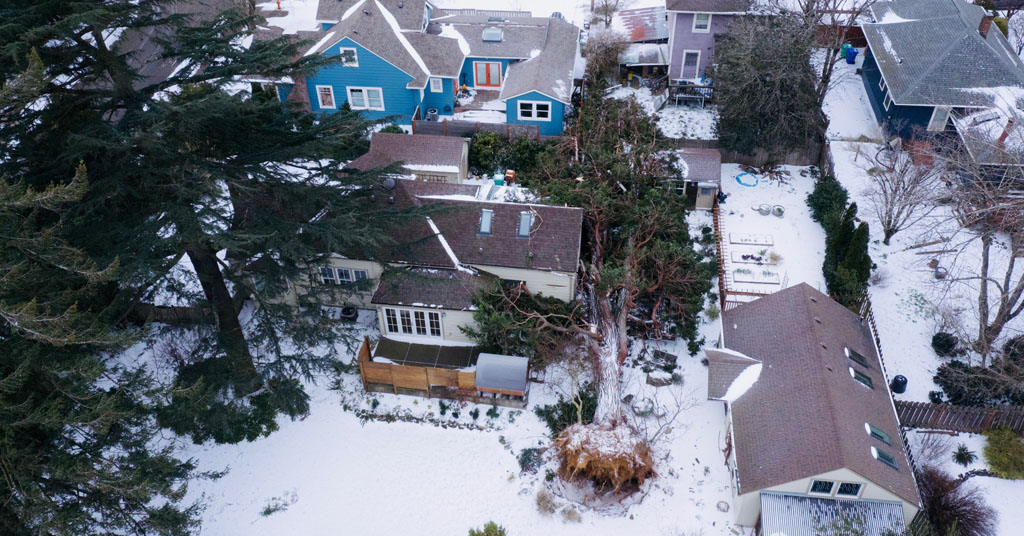
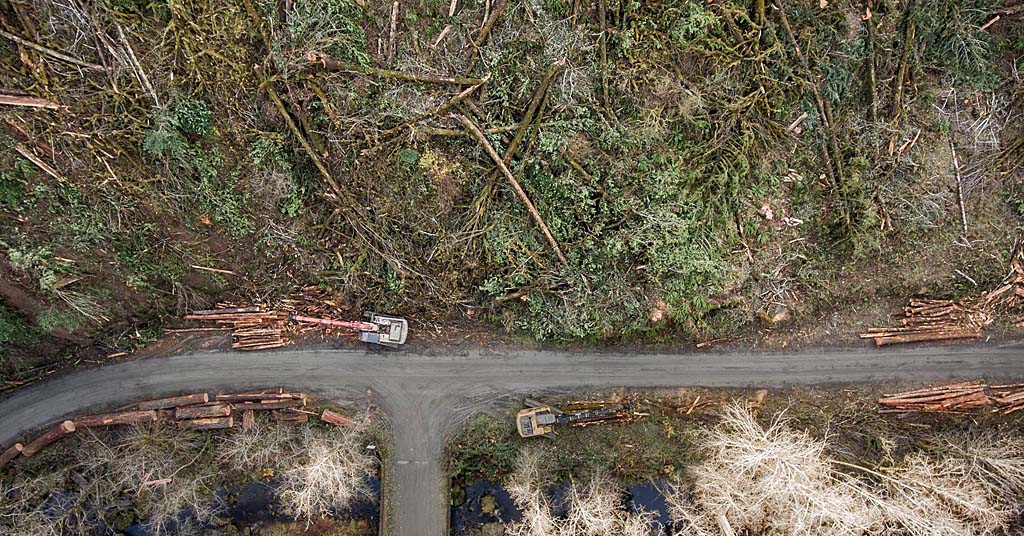



I’m so glad I saw this article in a recent Eugene Register-Guard newspaper. On the front cover!
It didn’t have all these excellent photos and graphics. Thanks for a very important article.
Lynne
Eugene, OR
It’s now Oct. and I could not find the Part 2 article. Can someone post it here. Thanks.
Here you go: https://columbiainsight.org/the-forest-service-is-experimenting-with-relocating-tree-species/
[…] “Firmageddon” to Western red cedars, drought has been implicated in the death of multiple tree species across the Northwest. Yet, how […]